Bringing (Accurate) Dinosaurs Back To Life
12:01 minutes
What does a Tyrannosaurus rex actually look like? You might immediately think of the iconic, roaring lizard from the Jurassic Park films. But scientific illustrator Gabriel Ugueto turns to paleontology studies and fossil finds—poring over the science to accurately reimagine creatures that no longer exist today. And what he renders might surprise you.
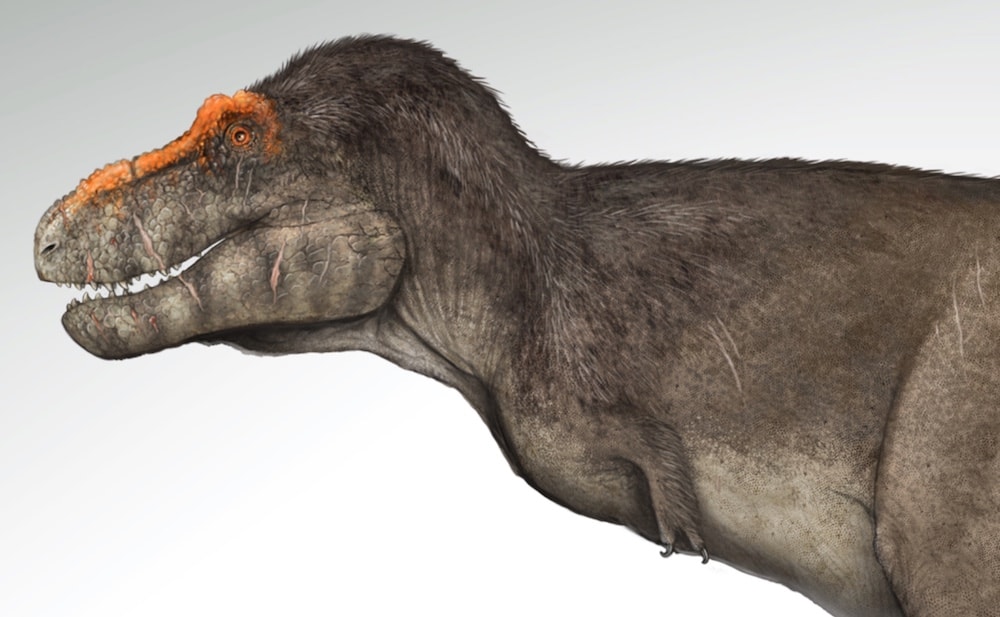
Ugueto, a former herpetologist, is a paleoartist, or an artist that creates representations of animals that have gone extinct. He has illustrated everything from extinct marine reptiles, insects, mammals, flying pterosaurs, and—of course—dinosaurs. His work helps scientists better understand and visualize the species they study. But bringing these animals back to life takes just as much imagination as careful precision. Ugueto draws upon the latest research, looks to fossilized bones, and collaborates with researchers to get a little closer to what these animals may have looked like when they roamed Earth. His more scientifically accurate reconstructions of chubby, scaly plesiosaurs or fluffy, feathery dromaeosaurs might not match the terrifying, reptilian dinosaurs of pop culture.
[Unearthing the last days of dinosaurs in Africa.]
More recent discoveries provide scientists and artists a new perspective on dinosaurs, Ugueto explains. “Contrary to popular media and what we’ve shown in movies, in paleoart, there is a huge renaissance to make these animals more accurate as to what they would have looked like,” Ugueto tells Science Friday.
Ugueto, profiled in the latest SciArts video, explains the challenges and wonders of his craft and breaks the stereotypes of how dinosaurs are depicted in popular media with guest host Flora Lichtman. View an animated breakdown of some of the important steps in Ugueto’s illustration process below. Plus, see a gallery of more of his reinterpretations here.
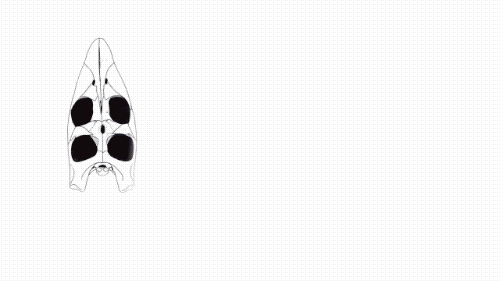
“When I get an assignment, I first try to look at the bones,” Ugueto says. “You start with the bones and then work outward from that.”
For example, “right now, I’m reconstructing a series of birds from the Cenozoic, and a lot of those birds are just known from one bone, a thigh bone. So I have to basically reconstruct the rest of the animal knowing what it could look like based on what animals it is closely related to.”
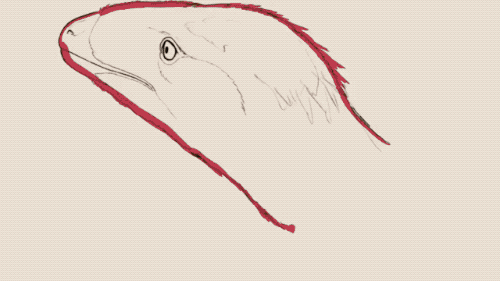
Since he often receives fragments of remains or photographs of the fossils, Ugueto then tries “to see what the animal that I’m going to reconstruct was related to,” he says. “It’s very important to have reference material from modern-day animals and to be very familiar with anatomy of modern-day animals when you try to reconstruct something from the past. Because not only will it give you analogues to what they could have looked like, but also, in a way, we’re all related at the end of the day. It’s important that we are familiar with that. For dinosaurs, for example, we know that birds are dinosaurs. So they probably share a lot of things in common.”
Feather-covered dinosaurs continue to be a controversial conversation. But, scientists have evidence that many groups of non-avian dinosaurs, including several dromaeosaurs, had different types of feathers. Some suggest that certain species may have even had feathers “exactly like the feathers that you would see on a pigeon,” Ugueto says.
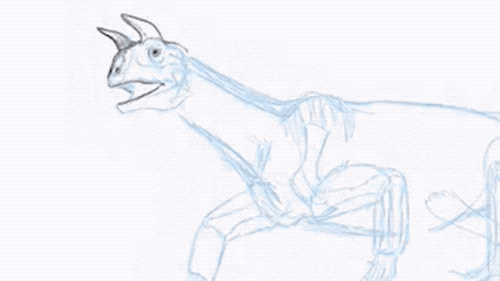
Understanding anatomy, like how muscles attach to bones, is important in accurately capturing different animals, Ugueto says. You can visualize how Ugueto carefully draws muscles and flesh in the illustration of a shringasaurus above.
[This veterinarian is visualizing anatomy unseen.]
“You definitely have to have a detailed knowledge of how muscles attach to different bones in different animals, because it’s not the same muscle attachment in mammals that it is for birds or reptiles,” he says. “After I’ve decided what position I’m going to put it in, I do a full skeletal reconstruction and then I try to see where the muscles could have attached. I continue with the reconstruction of putting skin, bones, and colors.”

The ecological backdrop is just as essential to depict correctly as the animal itself. Here, Ugueto poses a proceratosaurus dipping for a drink of water.
A big part of the process “is thinking where the animal lived [and] at what period in time, because there are different climatic conditions at different times during the history of life. Based on suggested habits of the animal, I think about what integument or covering I’m going to use, my coloration and all that.”
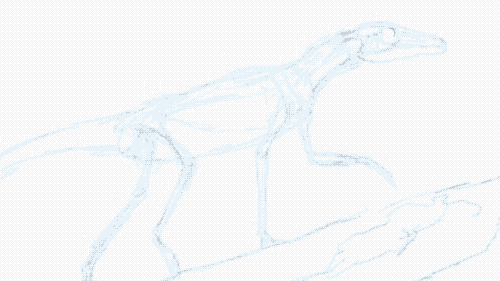
“I think [scientists] all have an idea of what the animal is going to look like, because you have to remember that these are people that have been looking at these bones for a long time, much longer than I have,” Ugueto says. “They have an idea of what the animal could have looked like, but I do get this feeling that they are pleased and very happy to see the animal finally fleshed out, with flesh, and bones, and muscles, and color, and looking alive.”
“I would have loved to see it alive,” Ugueto says.
Gabriel Ugueto is a paleoartist and science illustrator based in Miami, Florida.
FLORA LICHTMAN: Now, close your eyes and picture a dinosaur, any dinosaur. Do you have one in mind? Now, think about where that mental image came from. Maybe it was a drawing you saw online; or a children’s book; or a museum exhibit; or if you were alive before 1993, perhaps it was a certain blockbuster film about dinosaurs. Every one of those dinosaur images though had to be created from clues that dinosaurs left behind, like bones; and footprints; and fossils; and yes, feathers. And this means that we owe our understanding of dinosaurs just as much to artists as we do to scientists because it’s the artists who take scientific evidence and turn it into a picture. And those pictures of what dinosaurs looked like have changed dramatically in the last 20 years, which means that your vision of a dinosaur might need a refresh.
Here to tell us more is Gabriel Ugueto. He’s a paleoartist and science illustrator, who lives in Miami, Florida. He’s also the subject of our latest SciArts video. If want to visualize the animals that he is talking about, go to our web page, sciencefriday.com/dinoart. Welcome, Gabriel.
GABRIEL UGUETO: Hi.
FLORA LICHTMAN: And we welcome your questions about dinosaurs as well. Do you have a myth– a dinosaur visual mythbuster that you want busted? Give us a call. Our number is 844-724-8255. That’s 844-SCI-TALK. Or tweet us @scifri.
OK, Gabriel, I want to start with I think the classic dinosaur image, which is the Jurassic Park T. rex.
[LAUGH]
What is wrong with this picture?
GABRIEL UGUETO: Well, back when the original film came out, not much was wrong with it. But today, I mean with what we know, um, you can say a few things. That, for example, T. rex probably had prominent lips. And when I mean lips, like most of the teeth would have been covered. It probably also has some sort of feather covering on top of its body.
FLORA LICHTMAN: Really? Where?
GABRIEL UGUETO: Probably, like on the dorsal part of the neck and probably on the dorsal part of the body, especially on the trunk.
FLORA LICHTMAN: I’m thinking about long mohawk.
GABRIEL UGUETO: Probably. I mean we don’t know. And there is no direct evidence for it. But relatives of Tyrannosaurus, early relatives of Tyrannosaurus, have been found to be completely covered in feathers, from head to toe.
FLORA LICHTMAN: Wow.
GABRIEL UGUETO: So Tyrannosaurus was a bigger animal. And it probably lived in a warmer climate. So it probably needed less covering. But it most likely still probably had some sort of covering.
I mean think about elephants, for example. They look naked. But in reality, they have small hair, like a little bit of fuzz on top of their body.
FLORA LICHTMAN: Yes. What are the other popular misconceptions about dinosaurs that stem from the way they’re drawn or the way we see them in movies?
GABRIEL UGUETO: Well, especially in Jurassic Park, I think the biggest, biggest misconception is the raptors, like velociraptor. The velociraptor in the movie is much bigger than the original velociraptor would have been, the actual velociraptor would have been. And velociraptor was really completely covered in feathers. And it had–
FLORA LICHTMAN: Well, how small was it?
GABRIEL UGUETO: Well, about the size of a turkey.
FLORA LICHTMAN: Oh.
GABRIEL UGUETO: However there was a raptor species called Utahraptor, which was about the size of the one in the movie. But the problem is that one would also be covered completely in feathers. And it would probably look more like a giant turkey.
FLORA LICHTMAN: A very threatening turkey.
GABRIEL UGUETO: A very threatening turkey, with very big claws and teeth.
FLORA LICHTMAN: You also, I hear, have a beef with dinosaur skinniness.
GABRIEL UGUETO: Yes. Well, I think for a long time paleoarts suffer from shrink-wrapping everything, skin wrapping everything. Like, you know, there was no room for muscles or fat tissue. And if you look at animals alive today, you see how much– most of the skeletal structure is hidden by the muscles, and skin, and fat. So you don’t see much of the actual shape of the bone.
So right now we’re in the middle of, like, a revolution in paleoart because a lot of artists, like myself, are depicting dinosaurs with what I consider is a lot more natural– a more natural look, like including room for fatty tissue, muscle, and probably thinking of different types of integument, like feathers or scales in different part of their body.
FLORA LICHTMAN: Well, speaking of feathers, why do people object to the feathers?
GABRIEL UGUETO: Honestly, I didn’t know. I mean, I think a lot of people have this image of dinosaurs as monsters in movies. So I think when you reconstruct them with feathers, some people may think that they look less scary. But I actually don’t think that’s the case. I think, like we were saying before, if you find a raptor that was covered in feathers but was still very much a raptor– although I don’t really like to use that term raptor– but very much a velociraptor–
FLORA LICHTMAN: Why don’t you like the term raptor?
GABRIEL UGUETO: Well, because raptor is used in biology to refer to birds of prey originally. The movie called Dromaeosaurs, which is what raptors– they called them raptors in the movie. But that’s not the actual name. The actual name should be Dromaeosaurs.
FLORA LICHTMAN: Hm. I want to go to the phones. Let’s go to Tim in Oklahoma City. Hi, Tim.
TIM: How are you guys doing?
FLORA LICHTMAN: Great. What’s your question?
TIM: My question was what kind of, if any, modern living animals do you take measurements from to reconstruct the look of dinosaurs? I’m thinking along the lines of, like, John Gurche does, measuring modern humans and chimpanzees to help reconstruct tissue mass for early hominids?
GABRIEL UGUETO: Yes. I think that’s very important. I think, looking at today’s dinosaurs, which is modern birds, and their relatives, like crocodiles, it’s very, very important to understand how their muscles and how the other integument will be in dinosaurs.
I spend a lot of times in the zoo, looking at birds and crocodiles and to understand how they look and how they look at life themselves, to understand how they behave. Because more than likely, dinosaurs would have behaved in a similar way.
FLORA LICHTMAN: I’m Flora Lichtman. And this is Science Friday, from PRI, Public Radio International.
Gabriel, how do you decide what colors to use?
GABRIEL UGUETO: Well, I take into consideration several things. First of all, nowadays, there’s a lot of superamazing discoveries in many fossils that have preserved impressions of feathers or scales. Paleontologists have discovered that melanosomes, which is a structure that is responsible for color in animals, fossilize.
So we can now tell more or less the coloration of some dinosaur species. Like, for example, the archaeopteryx is known to have been primarily black. So if we have skin impressions, which is very rare, we can probably say a little bit about the coloration, the actual coloration. Otherwise, I look a lot at what the climate was where the animal lived, what type of habitat it lived in, and what are the suggested habits that the animal had, to make an educated guess of what it could have been colored.
FLORA LICHTMAN: Do dinosaur feathers look the same as bird feathers?
GABRIEL UGUETO: Some. I mean dinosaurs had a wide range of feathers, of feather types. There were some that looked more like hair. They were monfilamentous. And there were others that were pennaceous, like today’s birds.
For example, to give you an example, velociraptor, or some other dromaeosaurids, had something that looked more like fuzz on their bodies. But their wings, their hands, had pennaceous feathers, like today’s birds.
FLORA LICHTMAN: Let’s go to the phones. Let’s go to Robin in Orlando, Florida. Hi, Robin.
ROBIN: Hi. How are you today?
FLORA LICHTMAN: Great.
ROBIN: So I am a sixth grade teacher. And I have a student who loves dinosaurs and loves drawing birds. And he’s actually really, really good at it. And I was wondering what resources I could point him to, to maybe look into a career in paleoart?
GABRIEL UGUETO: Well, I think the most important part is the art part of the career. I mean you have to study illustration or graphic design, something that points you in that direction. Also, there are careers specialized in scientific illustration. And I would say one of the most important things, to be familiar with your subject. So you have to read a lot of scientific papers and get really involved in that community.
Read a lot. A lot of the process for me to create an animal, I have to research a lot and read a lot of scientific papers. So it helps a lot to know a lot about the subject.
FLORA LICHTMAN: Thank you, Robin. Gabriel, have you always been a dinosaur geek?
GABRIEL UGUETO: Yes.
[LAUGHTER]
Since I remember. I mean, since I was a kid. And I grew up with the new movies. And I was always interested in animals, but in particular dinosaurs. And that took me to my other love, which are reptiles.
FLORA LICHTMAN: What do you love about them?
GABRIEL UGUETO: They’re just amazing animals. I think they’re so– well, first of all, they look amazing. There’s nothing that look like them today. And they are so impressive, their size, and the way they behave, and how they dominated life on Earth for so long. They were so well adapted to the environment.
FLORA LICHTMAN: This might be like naming your favorite children. But do you have a favorite dinosaur?
GABRIEL UGUETO: No. It’s very difficult. And it is like naming your favorite children.
I guess– I don’t know. I think I’m a little bit partial to theropods, which is this group of dinosaurs that are carnivorous, like includes, like, tyrannosaurs and velociraptor. But honestly, it’s very difficult. I mean, I love them all.
FLORA LICHTMAN: In the 10 seconds we have left, can you tell me what to look for when I look at a drawing of a dinosaur so that I know it’s a good one, like that it’s lifelike and good?
GABRIEL UGUETO: A big telltale sign is if you can see the skull shape, the exact skull shape in the drawing of an animal that should be alive, then it’s not a good drawing because you’re seeing something that just put it like– it’s not a good drawing.
FLORA LICHTMAN: That’s a perfect place to leave it. Thank you, Gabriel.
GABRIEL UGUETO: All right. Thank you. Thank you for having me.
FLORA LICHTMAN: Gabriel Ugueto is paleoartist and science illustrator in Miami, Florida. And you can see our latest SciArts video of Gabriel’s work on our website, sciencefriday.com/dinoart, courtesy of our video producer, Luke Groskin.
Copyright © 2018 Science Friday Initiative. All rights reserved. Science Friday transcripts are produced on a tight deadline by 3Play Media. Fidelity to the original aired/published audio or video file might vary, and text might be updated or amended in the future. For the authoritative record of Science Friday’s programming, please visit the original aired/published recording. For terms of use and more information, visit our policies pages at http://www.sciencefriday.com/about/policies/
Christie Taylor was a producer for Science Friday. Her days involved diligent research, too many phone calls for an introvert, and asking scientists if they have any audio of that narwhal heartbeat.
Lauren J. Young was Science Friday’s digital producer. When she’s not shelving books as a library assistant, she’s adding to her impressive Pez dispenser collection.